Nature notes from the Wyre Forest
Each month, Guild Companion Linda Iles, who lives at Uncllys Farm on Ruskin Land, writes a diary about the changing seasons and activity on the land.
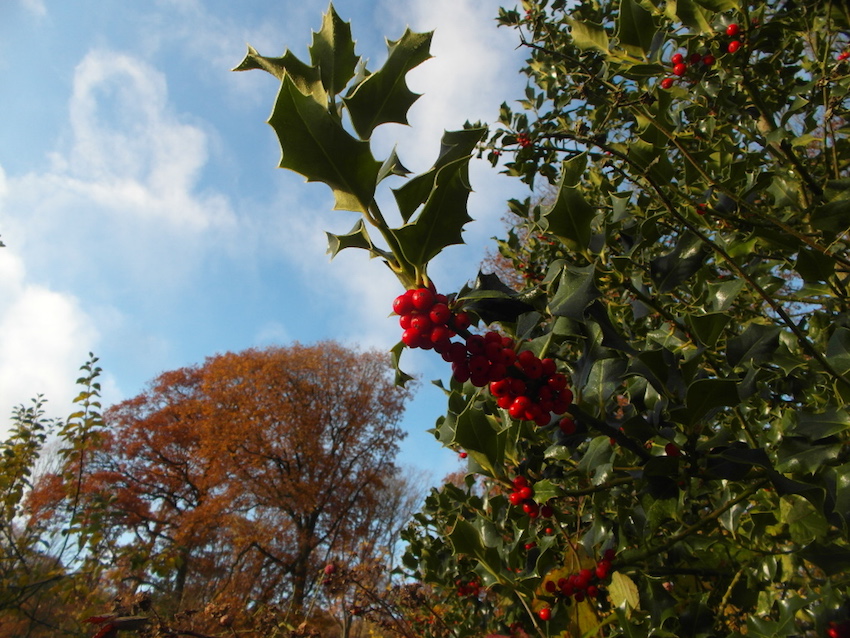
December 2018 in the Forest
With nearly all the leaves gone from the forest's deciduous trees, now is the time to gather evergreens to decorate our homes. This practice dates from at least Roman times, when the midwinter feast of Saturnalia brought some fun to the gloom of the year's shortest days. Masters and servants would swap roles and normal rules were suspended. When the traditions of Saturnalia were absorbed into the Christian celebration of Christmas, greenery kept its place in homes and barns and it may also have been the origin of the practice of electing a 'Lord of Misrule' to preside over the Christmas revelries.
Holly is the most plentiful native evergreen and has some useful symbolism to recommend it too: the prickles like the thorns of Christ's crown, red berries that mirror the red blood of his sacrifice, white flowers pointing to the purity of the Virgin Mary. Ideas that holly might have bean a 'witches' tree' still lingered and may have been the reason why it was considered unlucky to bring it indoors until Christmas Eve. Nicely berried sprigs of holly were harvested in the forest and used to make decorative wreaths. I remember our neighbour spending many cold hours in her shed in the forest and getting sore fingers turning out these wreaths - not an easy way to earn some extra Christmas cash.
Mistletoe, with its strange shape and growing habits, not to mention its association with Druids, was regarded with great suspicion. In most churches it was forbidden but its underground reputation as an aphrodisiac and fertility booster ensured that a bunch would be found hanging in many houses. It is a semi-parasite of many trees (taking water and minerals from them but photosynthesising for itself) and can be seen on poplar, willow, apple and hawthorn. I recently became aware that the large lime tree I was standing under at Hartlebury Castle was full of mistletoe when I saw the ground scattered with large numbers of its leaves, torn off in a storm. It grows well in this part of the country due to the mild, damp climate and abundance of suitable hosts, and Tenbury hosts auctions of mistletoe and holly in late November and early December that go back 160 years.
Using 'Christmas trees' to decorate the house probably has a long history but Prince Albert is credited with making the practice much more popular in Victorian times. Today we can choose from a variety of exotic conifers: spruce, pine and fir; and these can be bought from local growers and the Forestry Commission.
I wish you a very happy Christmas and time to draw breath before we plunge into 2019!
Linda Iles
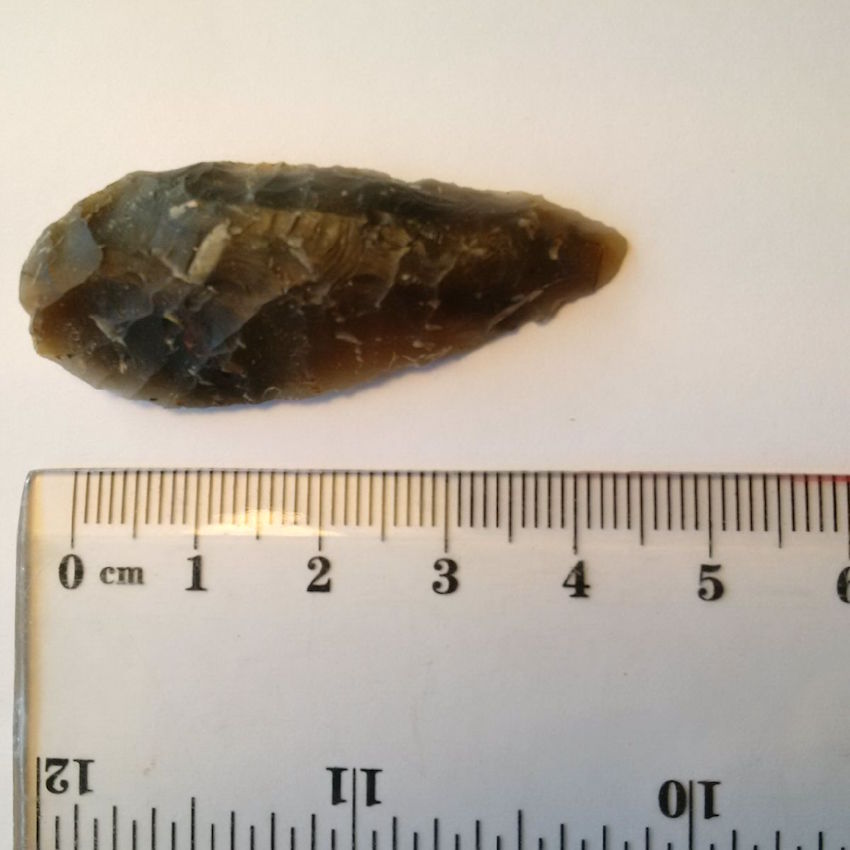
November 2018 in the Forest
A few days ago I made a very exciting discovery in the forest. There I was, walking along the track, mind elsewhere, when I saw something interesting by my feet. It was the shape of a small leaf and looked like…..flint. The flat side was uppermost and it came out easily enough. Could it be an artefact? I’m used to this scenario: it looks like an arrowhead (substitute axehead, piece of pottery, fossil, rare insect etc.) but it always turns out to be something mundane and of interest to no-one else.
I sent a photo to County Archaeologist, Adam Mindykowski, when I got home, and he soon replied to say that it was almost certainly an arrowhead. Here in my hand was something made by someone a few thousand years ago (Adam and his colleagues may be able to narrow it down) and used in the Wyre Forest. There is no flint anywhere near us, so it must have been traded.
That wasn’t all that I found on the same walk. Not far along the same track there was a Slow-worm, stationary, right out in the middle. I expect it had felt the vibrations of my approaching footsteps and was playing dead. It was about 35 centimetres long and a particularly dark bronze. I decided to give it some help to reach the track edge and it set off again, tongue flickering. I also came across two dung beetles (also called Dor beetles) ambling along the path with their slow, clockwork-like movement. I’m talking about a warm day which will be nearly a month ago when you read this. This month the temperature will have dropped and I won’t be able to see either of these: the slow worm will have found somewhere to hibernate and the beetles will have died, leaving their eggs in an underground nest provisioned with dung or decaying leaves for the larvae which will hatch next spring. The dead adults are often seen along paths, frozen mid-stride, no longer able to object to an examination of their strikingly iridescent purple undersides.
Now large numbers of ladybirds are trying to get into our house and many more creatures are going into hibernation now. The one which most readily springs to mind is the hedgehog, so familiar but so beleaguered now. Please do remember to check your bonfire piles on firework night for sleeping hogs or, better still, only build your fire just before you light it. Personally I always start a bonfire on clear ground and add material to it, so there’s no danger of cooking a spiny friend.
Linda Iles
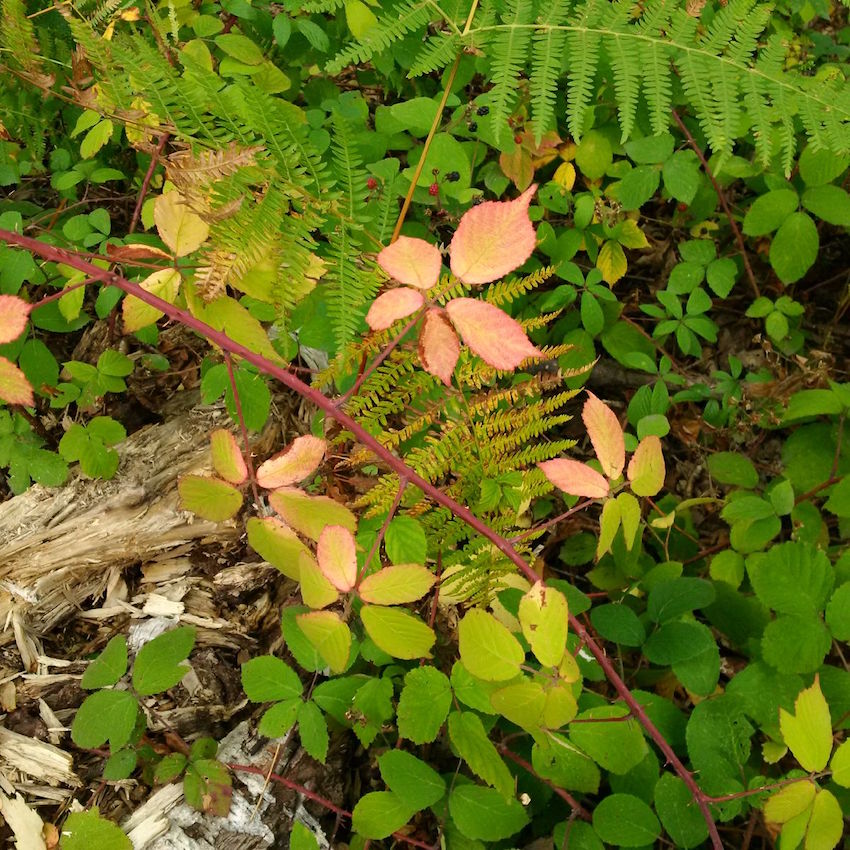
October 2018 in the Forest
Just when I thought I had seen the last of the decent blackberries I came across a whole row of ‘late developers’ growing fat and juicy down by the stream. Such staggered ripening is beneficial to all blackberry lovers, including fox, hedgehog and blackbird, and it could be an advantage to the bramble plant (if it is a genetic trait) as the berries are meant to be eaten and the seeds distributed rather than falling on the ground below.
All through the summer there has been a succession of fruit ripening, from the strawberry onwards. Last month was the turn of the elderberries and rowan berries but they have been set upon by hungry birds and the trees have lost their colourful decorations. Some of our less common forest trees have also fruited well: the alder buckthorn, selected by brimstone butterflies as a caterpillar food plant, has borne its small, black berries and the wild service tree will keep its bunches of brown fruits until after the first frosts.
For the moment the forest is still full of colour: the gold of the oak, the buttery yellow of birch, red of wild cherry and the orange of wild service. Looking just for colours, you will probably find the brightest reds on the dying leaves of sorrel, dock and bramble. I love that stage of the autumn when these colours are still evenly mixed with green.
Sloes, the fruit of the blackthorn, are now getting ready to be eaten or picked, benefitting from a frost to soften them. I suppose wild animals do eat them, despite their memorable astringency (once bitten, never forgotten). I know of only one use for them: sloe gin. Here is the recipe to make 1 litre of gin:
450g sloes (frosted or pricked with a pin), 450g sugar, 600ml gin
Put the sloes in a large jar or demijohn with a screw top, add the sugar and then the gin. Invert and give it a good shake to mix, and do the same every day for a week. After that, shake once a week for 10 weeks. Sieve and bottle. Keep in a dark place for at least a year to mellow.
This makes a rather syrupy liqueur. I fancy making a drier version this year by halving the sugar then diluting this with tonic. Cheers!
Linda Iles
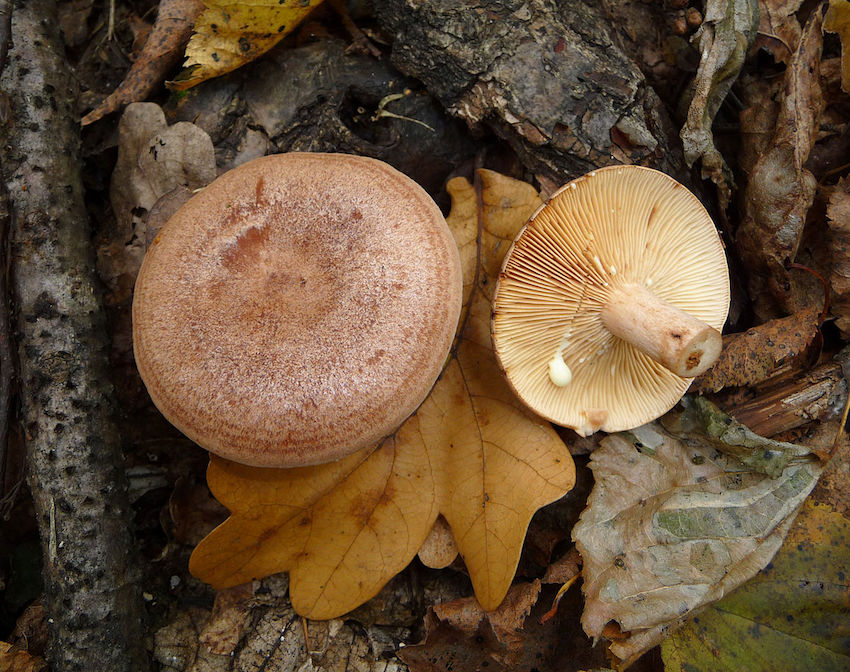
September 2018 in the Forest
This could be a very good year for mushrooms and toadstools. I say this because a period of heavy rain after dry weather usually stimulates the growth of the variously-shaped and coloured fruiting bodies which we see on the forest floor and out in the meadows. The greater part of the organism consists of a network of fungal threads called hyphae growing through the soil, dead wood and leaves (and often visible if you turn over a rotting log or clump of dead leaves).
Now that I’ve touched on fungal nomenclature I can reveal that the network is called mycelium and that a specialist in the study of fungi is a mycologist. Mycologists have recently made some astounding discoveries about fungi and their importance to the ecology of many other species. The most startling is that by far the largest living organism in the world is an example of the fungus Armillaria solidipes (a species of honey fungus) which extends for about 4 square miles in the Malheur National Forest of Oregon. DNA checks have proved that this is all one organism and it is estimated to be from 2000 to 8000 years old. Unfortunately it is a killer of coniferous trees, travelling through the soil by means of strong black ‘bootstraps’ by which it infects other trees’ own root systems. I have found these honey fungus bootstraps in parts of my garden, and have to blame myself for introducing them via picturesque logs and stumps.
Fortunately the relationships between trees and fungi are usually more benign and beneficial. Fungi cannot photosynthesise, absorbing nutrients and water directly from their surroundings and most notably from dead matter. However, many have evolved to form a close association with trees where they benefit from the sugars produced by the tree and the trade-off for the tree is a more effective system for gathering minerals from the soil and filtering out heavy metals. This co-operation of the fungal mycelium with tree roots results in an extensive ‘root’ system which can link one tree with another over large areas.
Particular fungi may be fairly specific in their choice of host tree. The Oak Milkcap, one of about 50 species of milkcap found in the Wyre Forest, is shown in the photo: the ‘milk’ which gives it its name oozing from the damaged gills. It is, I believe, exclusively associated with oak trees, whereas, for instance, the Fiery Milkcap grows under Hazel, Fly Agaric under birch and Slippery Jack under Scots Pine.
Local gourmets may be rather sad to learn that edible truffles cannot grow in the Wyre Forest’s acidic soils, so plans to train up the dog or pig as a truffle-hunter would get us nowhere. I won’t get into the tricky subject of whether or not different fungi are edible: after an allergic reaction to eating a Common Puffball I prefer to steer clear of them all.
Linda Iles
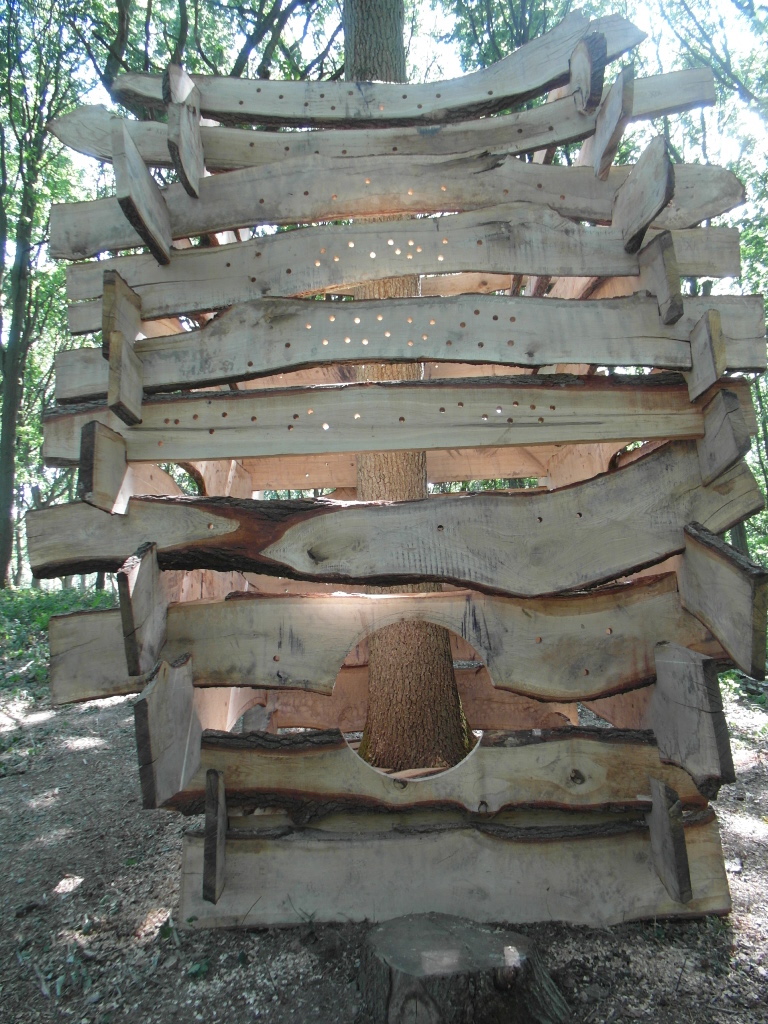
August in the Forest
As I write, the forest has just said goodbye to about 60 practicing architects and students on a 3 day residential summer school. ‘Studio in the Woods’ is held annually but this time was hosted by the Guild of St George and Wyre Community Land Trust in the Guild-owned area of woodland known as Ruskin Land. The teams collaborated in the design and construction of 6 very unique and individual structures using timber from the Wyre Forest which would otherwise have had little or no commercial value: everything from small laths and branches to planks of slab wood still with bark attached. The photo shows possibly my personal favourite which, as I took the picture, twinkled with light as the canopy above moved in the breeze. These structures were temporary but have still been an important part of the ‘Ruskin in Wyre’ project which celebrates the cultural legacy of John Ruskin and his followers in our neck of the woods (see ruskinland.org.uk ).
By the time you read this I’m hoping that the summer’s drought will have been broken. The hot weather brought fruits and nuts on to ripen early, but the extreme water shortage last month halted flowering and sequential fruiting in many food plants. Bell Brook managed a mere trickle of water between pools although the old well that supplied Uncllys Farm maintained its supply. I could imagine the anxiety that people would have experienced in old days as they saw vital water supplies dry up and crops wilt.
Some creatures seem to have done well this year. Pearl-bordered and Silver-washed Fritillary butterflies have been flying in the newly-created rides, warmed by the sun. Under the safety of our corrugated iron refuges we have seen many juvenile Grass Snakes and families of Slow Worms. When disturbed, the latter take a moment or two to take stock of the situation then can move off at speed, belying their name. They have the ability to shed the tip of the tail to escape predators and I have seen a few individuals with evidence of a regrown tail. As Norman Hickin says in ‘The Natural History of an English Forest’, ‘the scaling at the joint does not always appear to fit very well’. I’m fond of these bronze-coloured snake-like lizards, and would be pleased to have more of them tucking into the local slug population. The young, I learn from Norman Hickin, hatch from the eggs on being laid, or very shortly afterwards, and are silvery with a black line down the centre of the back.
Lastly I’m pleased to report that Swallows came at last to Uncllys Farm and 2 nests were built in the eaves of the Studio. We hope to see House Martins joining them next year.
Linda Iles
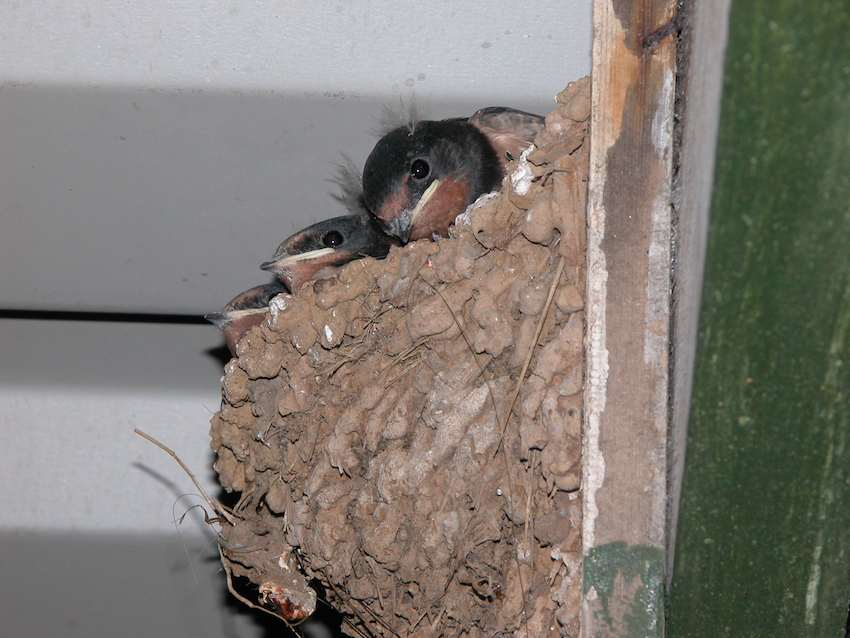
Photo by Rosemary Winnall
July in the Forest
This will be the first year since we moved to Uncllys 14 years ago that there will be no House Martins or Swallows nesting here. I’ve done my best: there’s a dustbin lid full of damp mud for their nest-building and the old nesting sites are still there. A few individuals have visited on sunny days, raising my hopes and lifting my spirits as they swoop around the barn and house. The Martins like the gable ends of the house, and have even inspected the remains of old nests there, but nothing has come of it. In the past Swallows have nested in the barn roof and the eaves of the Studio, preferring a more open aspect (as the estate agents might put it).
I wonder what’s going on? ‘Springwatch’ and various websites have mentioned that these migrants have had a peculiar and sporadic arrival this year most probably caused by the long winter and storms. I hope they are making up for lost time somewhere. I miss their busy comings and goings and the little faces of the nestlings looking out for their parents’ returns with beaks full of flies. Did I say, ‘Beaks full of flies’? That may be the answer to the mysterious absence of the swallow family, as insects just don’t seem to be around in large numbers any more. When you come back from a car journey is the front of the car covered in squashed flies? That would have been normal 30 years ago. I suspect this has something to do with the widespread use of insecticides in our gardens and, even more so, in the wider countryside. I see that Chris Packham has been talking to the media about an ‘ecological apocalypse’ creeping up on us in Britain. One of the trends he mentions is the decrease in insects such as moths and crane flies which come in at night through open windows in his home in the New Forest. I’ve noticed the same thing – something must surely be wrong if there are hardly any crane flies in the middle of a National Nature Reserve (and our children don’t know what a ‘Daddy long legs’ is!).
However, I have heard a cuckoo several times this year (perhaps the same one each time), so the ‘Silent Spring’ isn’t quite upon us yet. And there is always hope that something can be done to reverse the evident declines in nearly all of our wildlife: look at the Pearl Bordered Fritillary butterfly which is increasing in numbers thanks to positive efforts to increase its habitat along forest rides. The Red Kite too is being seen more and more in this locality, continuing its spread through England thanks to reintroductions from the small population in Wales which survived the persecution of less enlightened times.
Linda Iles
